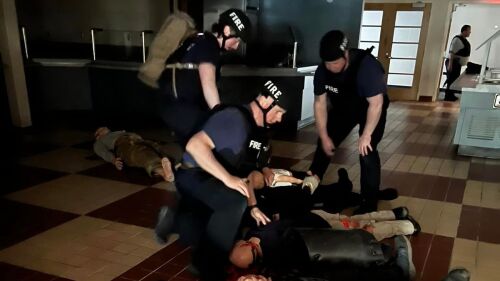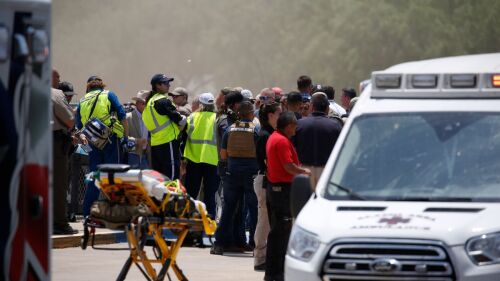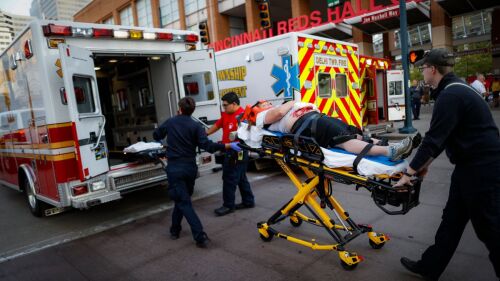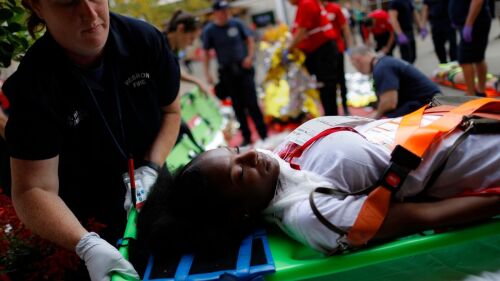What happened: Moments after the Kansas City Chiefs Super Bowl victory parade concluded, shots were fired into the crowd of celebrants gathered in front of Union Station in downtown Kansas City, Missouri. One person was killed, and at least 21 other people, including nine children, suffered gunshot wounds. More people may have been injured as the crowd ran for cover and concealment.
Why it’s important: This is yet another tragic reminder that any mass gathering is a potential target for a shooter with murderous intent. It is also an important incident because almost half of the victims shot were children. This incident happened outdoors on the streets of a major U.S. city. Bystanders, acting as lay rescuers; law enforcement officers; and EMS personnel had immediate access to the victims. Rapid triage, and limited on-scene airway management and bleeding control, followed by transport to a hospital may have contributed to the low number of casualties.
Key takeaways
It is still early and there is much we don’t know about this incident. Police have three people in custody, the motive is unknown and two of the hospitalized adult patients are in critical condition. All the children are expected to survive their gunshot wounds. As we review the incident and learn about the actions of rescuers, here are a few key takeaways.
1. Stop the killing. Bystander video shows police and civilians tackling suspects, preventing further shooting and stopping the suspects from leaving the scene. Their quick, selfless and heroic actions may have saved many lives.
2. Stop the dying. The second immediate action at an active shooter incident, regardless of the patient’s age, is to stop the dying by identifying the wounded, assessing for and stopping severe bleeding, using manual maneuvers to open a patient’s airway and applying a chest seal to penetrating chest wounds. I expect in the days ahead to see news reports of bystanders and rescuers applying direct pressure to bleeding, using improvised and commercial tourniquets, and delivering chest compressions and rescue breaths until EMTs and paramedics arrived to care for the wounded adults and children.
3. Safe transport, rapid only if indicated. Transport is an intervention or treatment for an injured patient. If transport resources are limited, prioritizing patients for transport is the first part of the treatment. The second part is safely delivering patients to receiving hospitals. Add rapid transport to the intervention only if indicated, based on your assessment of the patient’s conditions and local protocols.
4. Distribute patients to receiving facilities. Logically, the most serious patients should go to the nearest hospital, but that hospital might be quickly overwhelmed. If a pediatric trauma center is in your region, taking severely injured children to that hospital, even if it is a further transport distance, might be the best transportation choice. However, not all pediatric patients, especially those with less serious and non-life-threatening injuries, need to go to a pediatric trauma center. Use training exercises and regional meetings to set expectations for distribution of patients to receiving facilities. During an actual incident, follow local protocols, and what makes the most sense for your patient’s wounds and condition.
5. Collect as much patient identification as possible. When transporting children, especially from a mass gathering and if you’re unable to transport the child’s parent or guardian, make sure to obtain as much patient identification as possible. Family reunification is a significant secondary complication of chaotic incidents and distributing patients to hospitals across a major metro area.
6. Transport a parent or guardian, if you can, safely. Follow local protocols for deciding if and how to transport a wounded child’s parent or guardian in the ambulance or quick response vehicle to the hospital. Only transport a parent or guardian if you can provide that person a seat with a seatbelt.
Finally, our thoughts are with the EMS, fire and law enforcement personnel who quickly responded to the incident, stopped the shooting and cared for the wounded. A day that started as a community celebration was interrupted by needless and senseless violence. Thank you for serving your community and making a difference in the lives of others. Please take care of yourselves and your colleagues in the difficult weeks ahead.








